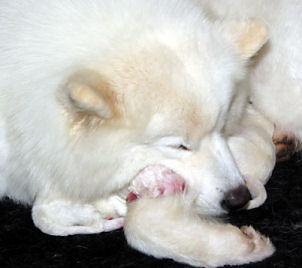Liaison: Gail Spieker
Email: tahogail@gmail.com
Fading Puppy Syndrome is not a specific disease or diagnosis, but a description of signs that may be due to environmental factors, genetic causes or infectious agents. It is used to describe a puppy that appears normal at birth, but “fades” - fails to grow and thrive during the first weeks of life. Sometimes it affects entire litters.

Signs and Symptoms
Fading Puppy Syndrome usually occurs in neonates (newborns) from birth to 3 weeks. Signs include not nursing, crying, and losing weight. The puppy may be limp. Feces may be soft and yellow green if fading is caused by the canine herpes virus.
Causes
Although the signs in Fading Puppy Syndrome appear the same, there are many causes that could be involved. It is essential to seek early intervention and diagnosis because puppies worsen quickly and may die within a day or two.
Environmental factors are one of the main causes of death in neonates. Poor mothering can cause puppies to develop hypothermia, in which the body temperature falls precipitously. Puppies in the first week of life depend on the mother, or on outside sources such as heat lamps or whelping room maintained at 85 degrees Fahrenheit, to maintain sufficient body heat. In those few days, puppies do not have the ability to shiver, and their body temperature varies from 95 to 98 degrees Fahrenheit. By the second and third week, normal body temperature rises to 97 to 100 degrees Fahrenheit. It is not until the fourth week that body temperature reaches 101.5 degrees Fahrenheit, which is normal for adult dogs.
In hot climates, or in environments kept too hot for the puppies comfort, hyperthermia may occur. Puppies may over heat in those circumstances and cry incessantly.
Dams who have Caesarean sections have litters with higher death rates than litters whelped naturally. There may be several reasons for this, one of them being that the maternal instinct is not as strong to mother the newborns, or factors resulting from the operation itself.
Environmental toxins are another cause of Fading Puppy Syndrome. Bedding materials or substances used to clean or wash the whelping box may be toxic to newborns. It may be advisable not to use pine oils/phenols;or bleach/ammonium based cleaners that come in direct contact with the puppies. It seems to be preferable to use mild cleaners with no strong odors that have been thoroughly rinsed before the puppies are returned to the whelping box.
Genetics also plays an important role in neonatal fatalities. Highly inbred litters, such as those from breedings of siblings, may have decreased litter size and a high neonatal mortality rate. Gross abnormalities are often found in the ill or deceased puppies. Cleft palates, atrophy of the thymus and cardiovascular defects are only three of the problems found in fading puppies.
Low birth weight is another factor in fading puppy syndrome. It can be associated with transient juvenile hypoglycemia (low blood sugar), a common cause of fatality especially in toy breeds. It occurs when feeding isn’t frequent enough to maintain blood sugar levels. Even if recognized and treated by feeding frequent small meals, the condition may persist for several months.
Infection, caused by either bacteria or viruses, is often associated with fading puppy syndrome. Neonatal septicemia is a systemic bacterial infection that could be transmitted through the mother or from an unclean environment. Viral infections, most frequently canine herpes virus contracted by the bitch during the last three weeks before birth, can result in abortion or early neonatal death. Canine parvovirus 1 (also called CPV-1 or minute virus of canines, MVC) ) is another cause of fading puppy syndrome. Vaccination of the dam for viral diseases prior to breeding allows her immunity to carry through to the puppies in her colostrum. Unfortunately, vaccines for canine herpes virus and canine parvovirus 1 are not currently available in the United States.
Finally, intestinal parasites, particularly roundworm and hookworms, which can cross through the placenta, may be a contributing factor in early puppy death.
Risk Factors
- Dam’s exposure to herpes virus prior to whelping
- Delivery by caesarean section
- Highly inbred litter
Treatment Guidelines
Note: Treatment of animals should only be performed by a licensed veterinarian. Veterinarians should consult the current literature and current pharmacological formularies before initiating any treatment protocol.
Call your vet immediately if you suspect a puppy is fading. Specific treatment will depend on what your vet feels may be causing the problem. Supportive care includes keeping affected puppies warm (room at 85 to 95 degrees Fahrenheit) and preventing dehydration with the use of an eye dropper to administer fluids such as Esbilac, water and liver juice.
References
Causes of fading puppy and kitten syndrome
by Joni L. Freshman, DVM, MS, DACVIM. dvm360 October
2005 
http://www.marvistavet.com/herpes-infection-canine.pml

http://www.heirlair.com/parvo.htm
 - Information on canine parvovirus 1 (currently available only through
internet “wayback machine”
- Information on canine parvovirus 1 (currently available only through
internet “wayback machine”
Suggested Links
If you experience fading puppy syndrome with a litter please see the suggested links to be better prepared should it appear with the next litter. If a puppy dies, an autopsy to understand the cause can help define preventive steps for future litters.
http://www.lowchensaustralia.com/breeding/fadingpups.htm

http://searsvet.50megs.com/Herpes1.html

http://showdogsupersite.com/kenlclub/breedvet/fading.html

https://www.petcoach.co/dog/condition/herpesvirus/

http://www.2ndchance.info/herpesvirusdog.htm

http://www.vetinfo4dogs.com/dherpes.html

http://www.provet.co.uk/health/diseases/parvovirus.htm
 - information on parvovirus 1 and how it
relates to fading puppies
- information on parvovirus 1 and how it
relates to fading puppies



